Do Energy Dissipation Processes at the Fracture Zone Put a Natural Cap on Campi Flegrei’s Quakes?
Published in Earth & Environment and Research Data
When the ground beneath a restless volcano shakes, it’s more than a tremor—it’s a glimpse into how Earth’s crust stores and releases energy. Our new study, just published in Nature Communications Earth & Environment, shows that at Italy’s Campi Flegrei caldera, most of the energy unleashed during earthquake fractures only a little fraction makes it into seismic waves. Instead, it vanishes as frictional heat and off-fault rock damage, acting as a natural brake on rupture growth and possibly limiting the maximum possible earthquake magnitude.
A restless giant on Naples’ doorstep, Campi Flegrei caldera is one of the world’s largest and most densely inhabited volcanoes. Home to several hundred thousand residents and bordering Naples—Italy’s third-largest city with over a million people—it formed from two huge eruptions about 39,000 and 15,000 years ago. Over the past 10,000 years, more than 70 smaller eruptions have dotted the caldera floor, the most recent in 1538 built Monte Nuovo after nearly 4,000 years of dormancy (Orsi et al., 2022).
Today, the caldera’s most visible restlessness is bradyseism (from the Greek words “bradús”, slow, and “seismòs”, ground movement)—slow vertical motions of its floor (D’Auria, L., et al. 2011). Since 2011, the ground has been rising again, and by August 2025 had uplifted about 1.45 meters at rates of 1–2 cm per month. Each acceleration in uplift has been accompanied by swarms of shallow earthquakes: more than 10,000 since the current episode began (De Landro et al., 2025). Yet despite their frequency, the strongest quakes have been modest—never exceeding duration magnitude Md 4.6 (moment magnitude Mw about 4.0). Peak ground accelerations of several tenths of g (1g = 9.8 m/s^2) have occasionally rattled buildings but caused only limited, mostly non-structural damage (Iervolino et al., 2024).
Dissecting 56 key earthquakes, we analyzed the largest quakes from 2020–2025 (Md 3.0–4.4, roughly Mw 2–4) to understand why they stay small. We used broadband and strong-motion records from three independent networks: OV-INGV’s local seismic stations, the Italian Strong Motion Network (RAN), and the University of Naples’ ISNet array.
We applied a time-domain method based on the P-wave log-displacement amplitude versus time. By extracting P- and S-phase corner times and plateau amplitudes, correcting for distance attenuation, we could solve for seismic moment, rupture radius and velocity. The results show ruptures were shallow, just 2–4 km deep, and small, with radii ranging 100–1000 m. Rupture speeds were sub-shear, about 0.6–1.2 km/s (roughly 40–90% of the local shear-wave velocity). Static stress drops spanned a broad range from 0.01 to 10 MPa, with many events below 1 MPa—values typical of fluid-rich, high pore-pressure volcanic crust.
Two independent proxies for dynamic stress drop—apparent stress and aRMS stress drop—consistently fell below static stress drops, indicating inefficient energy radiation.
Energy partitioning—where does the energy go?
We quantified seismic radiation efficiency—the fraction of released stress energy converted into seismic waves—and found it is generally low: 0.02–0.3, with a median of 0.1. In other words, only less than 10% of the available energy to generate the earthquake shook the ground. The rest was presumably lost into co-seismic frictional heating along faults and off-fault damage: inelastic fracturing, microcracking, and changes in rock stiffness and permeability. These processes act like sponges, soaking up energy that would otherwise drive the rupture or radiate shaking.
A striking pattern emerged: an inverse correlation between rupture velocity and stress drop. The more stress a quake releases, the slower its rupture spreads. This counterintuitive trend—robust even after excluding the largest events—supports the idea that high-stress ruptures cause intense local damage at the fault zone volume, which in turn slows the rupture front and prevents it from growing or radiating efficiently. The resulting positive dynamic overshoot—which indicates a larger static stress drop to apparent stress —further points to strong inelastic processes at play during the faulting process.
Why this matters for hazard and monitoring becomes clear when we consider the local context?
The current crisis at Campi Flegrei suggests that most earthquakes will remain moderate in size—typically below Md 4–4.5— even when repeatedly occurring along long mapped faults, potentially causative of larger magnitude events. If most of their energy is dissipated as heat and off-fault rock damage, as suggested by our findings, this process could effectively limit the rupture growth. This natural brake on earthquake size is reassuring for nearby communities, but it should not lead to complacency: the presence of long mapped faults means that, under rare stress and fluid conditions, larger ruptures cannot be completely ruled out. Hazard assessments must therefore incorporate both the low probability but possible occurrence of stronger events and the fact that shaking measurements alone underestimate the total energy released underground. Even moderate quakes can generate peak ground accelerations of several tenths g, posing risks to vulnerable structures. Furthermore, repeated small ruptures may progressively weaken the crust and alter fluid pathways, influencing future volcanic or seismic behavior. Integrating rapid rupture analysis with geodetic and structural monitoring will be essential to track evolving conditions and refine real-time risk evaluations during the ongoing unrest.
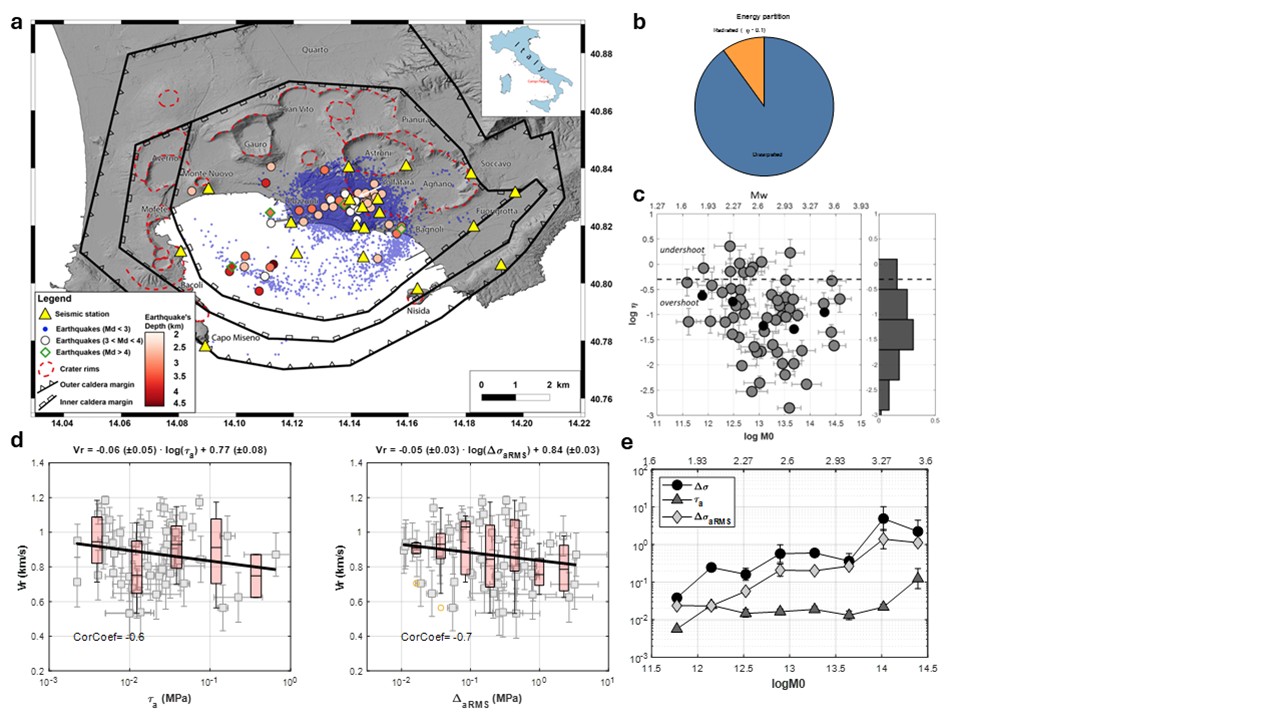
(a) Map of earthquake locations inside the caldera (colored by depth and size); yellow triangles mark seismic stations.
(b) How earthquake energy is spent: on average, only about 10% goes into seismic waves (ground shaking), while the rest is lost breaking and heating the surrounding rock.
(c) Efficiency of energy radiation compared with earthquake size: most events are inefficient, with much of their energy consumed locally rather than released as shaking.
(d) Link between rupture speed and stress: earthquakes with higher stress release tend to rupture more slowly, consistent with greater rock damage.
References
D’Auria, L., et al. Repeated fluid-transfer episodes as a mechanism for the recent dynamics of Campi Flegrei caldera (1989–2010). J. Geophys. Res. 116, B04313 (2011).
De Landro, G., Vanorio, T., Muzellec, T., Russo, G., Lomax, A., Virieux, J., & A. Zollo (2025). 3D structure and dynamics of Campi Flegrei enhance multi-hazard assessment. Nature communications, 16(1), 4814. https://doi.org/10.1038/s41467-025-59821-z
Iervolino, I., Cito, P., De Falco, M., Festa, G., Herrmann, M., Lomax, A., Marzocchi, W., Santo, A., Strumia, C., Massaro, L., Scala, A., Scotto Di Uccio, F., Zollo, A., 2024. Seismic risk mitigation at Campi Flegrei in volcanic unrest. Nature Communications, 15, 10474. https://doi.org/10.1038/s41467-024-55023-1
Orsi, G. Volcanic and deformation history of the Campi Flegrei volcanic field, Italy. In G. Orsi, M. D'Antonio, & L. Civetta (Eds.), Campi Flegrei: A restless caldera in a densely populated area, active volcanoes of the world. Springer Berlin Heidelberg, Berlin, Heidelberg. https://doi.org/10.1007/978-3-642-37060-1 (2022).
Follow the Topic
-
Communications Earth & Environment

An open access journal from Nature Portfolio that publishes high-quality research, reviews and commentary in the Earth, environmental and planetary sciences.
Related Collections
With Collections, you can get published faster and increase your visibility.
Geology of the Moon
Publishing Model: Hybrid
Deadline: Jan 31, 2026
Drought
Publishing Model: Hybrid
Deadline: Dec 31, 2025
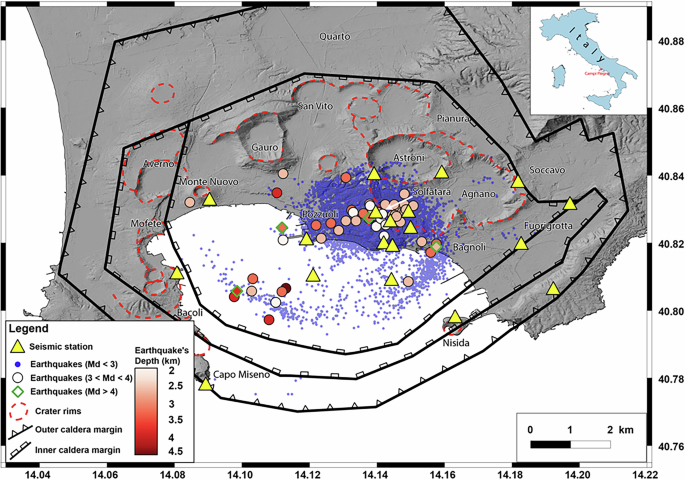
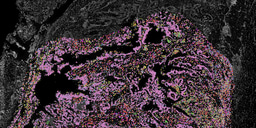


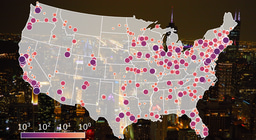
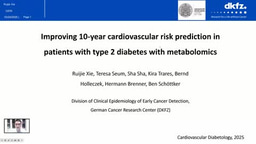
Please sign in or register for FREE
If you are a registered user on Research Communities by Springer Nature, please sign in